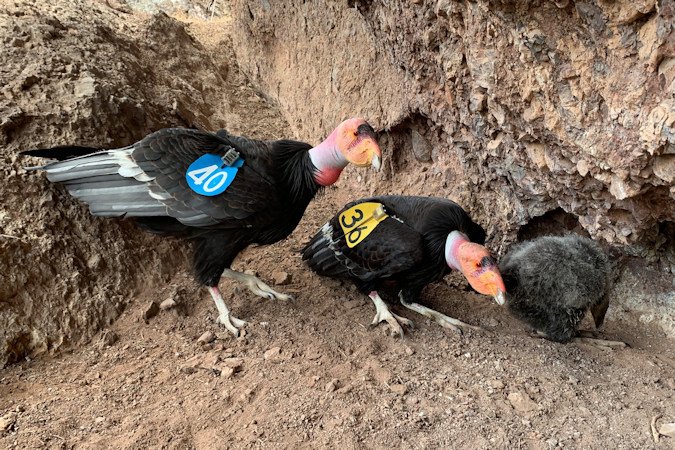20 years on, the first Oregon Zoo-raised condor is flying high at a national park in Central California

PORTLAND, Ore. (KTVZ) -- Call it one of those local-bird-makes-good stories: The first California condor to hatch at the Oregon Zoo’s conservation center just turned 20 years old in California's Pinnacles National Park. Kun-Wac-Shun, aka condor No. 340, hatched at the Jonsson Center for Wildlife Conservation on May 9, 2004, and has been flying free in Central California since 2005.
“It’s a great occasion to celebrate a species that not too long ago was on the very brink of extinction,” said Travis Koons, who oversees the zoo’s condor program. “In the 1980s, fewer than 30 of these birds remained on the planet. No. 340 has played a big role in the condor’s comeback.”
Named Kun-Wac-Shun (“Thunder and Lightning”) by Chief Nelson Wallulutum of the Wasco tribe, this resilient bird has spent the past 19 years in and around the majestic rock formations at Pinnacles, where he’s considered one of the most dominant males in the flock.
“Condors raised in Oregon have a reputation for toughness,” Koons said. “And that probably started with No. 340. He was the first one out, a true survivor, and he just might be the toughest of them all.”
Ten years ago, he paired up with No. 236, aka “Tiny,” and together, they have brought five wild-hatched chicks into the world — including the first condor to fledge from its nest at Pinnacles in more than a century.
It has not been an easy life though. No. 340 has been treated for elevated lead levels at least 15 times over the years — most recently at the Oakland Zoo in 2021. His first female partner, No. 444, died of lead poisoning in 2014, and his first offspring, the history-making No. 828, also succumbed, in 2022.
Accumulated lead poisoning — a problem that plagues all raptors and scavengers — remains the leading cause of death in free-flying condors. As the birds feed on animal carcasses, they can ingest lead from bullet fragments. This results in paralysis of the digestive tract and a slow death by starvation.
In 2015, the Oregon Zoo launched a program to encourage hunters, traditionally some of the strongest supporters of wildlife and habitat conservation, to choose non-lead ammunition — and in doing so help protect condors, eagles and other scavengers.
The California condor was one of the original animals included on the 1973 Endangered Species Act and is classified as critically endangered. In 1982, only 22 individuals remained in the wild and by 1987, the last condors were brought into human care in an attempt to save the species from extinction. Thanks to recovery programs like the Oregon Zoo’s, the world’s California condor population now totals more than 500 birds, most of which are flying free.
The Oregon Zoo’s condor recovery efforts take place at the Jonsson Center for Wildlife Conservation, located in rural Clackamas County on Metro-owned open land. The remoteness of the facility minimizes the exposure of young condors to people, increasing the chances for captive-hatched birds to survive and breed in the wild.
As part of Metro, the Oregon Zoo helps make greater Portland a great place to call home. Committed to conservation, the zoo acts globally on behalf of species from pikas to polar bears. Over the past 30 years, it has prevented extinctions, expanded populations, advanced conservation science and formed powerful communities to protect wildlife in the Northwest and around the world.
Upgrades and new equipment at the Jonsson Center have been made possible through continued support from the Avangrid Foundation and donations to the Oregon Zoo Foundation, which supports the zoo’s efforts in advancing animal well-being, species recovery work and conservation education. To contribute, go to oregonzoo.org/give.